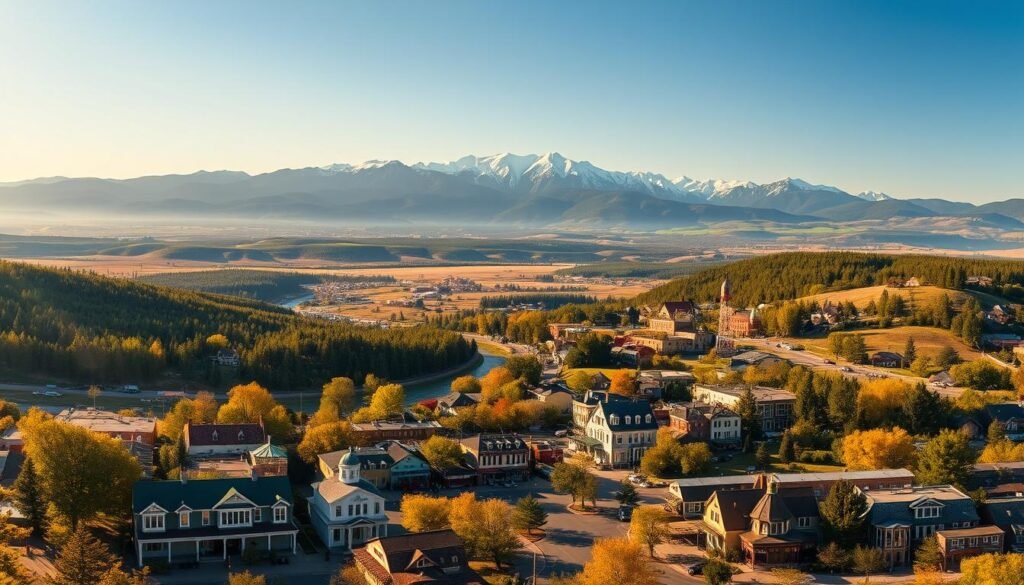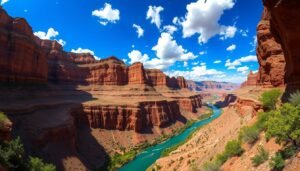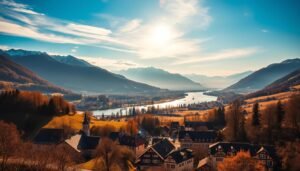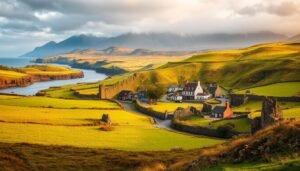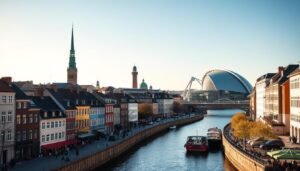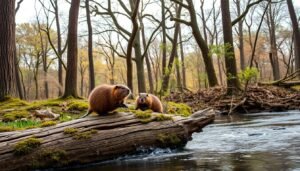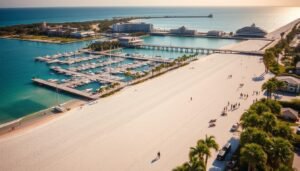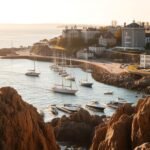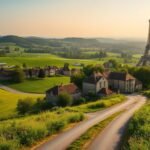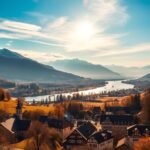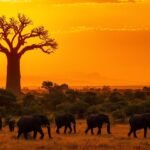Did you know that travelers often list a single U.S. destination as life-changing — whether it was a skyline, a canyon overlook, or a hidden restaurant? That mix of surprise and scale is exactly what I aimed to capture in this guide.
I built a short list that pairs buzzing cities like san francisco and New Orleans with giants of nature such as the Grand canyon and the South rim. I want you to see how the united states can feel like many worlds at once.
I focus on clear, practical tips for timing, where restaurants shine, and how people can link nearby places into a smooth travel day. My goal is simple: help you plan trips that balance city life, big views, and easy logistics without wasting time.
Key Takeaways
- I mixed cities and wild spots so one trip feels varied and doable.
- Expect big views at the canyon and quiet walks among the redwoods.
- Find my tips on timing and restaurants to cut planning time.
- Use short detours for museums, beaches, or photo ops during the day.
- This list highlights places that reward a little effort with lasting memories.
How I Pick the Best Places to Visit in the USA
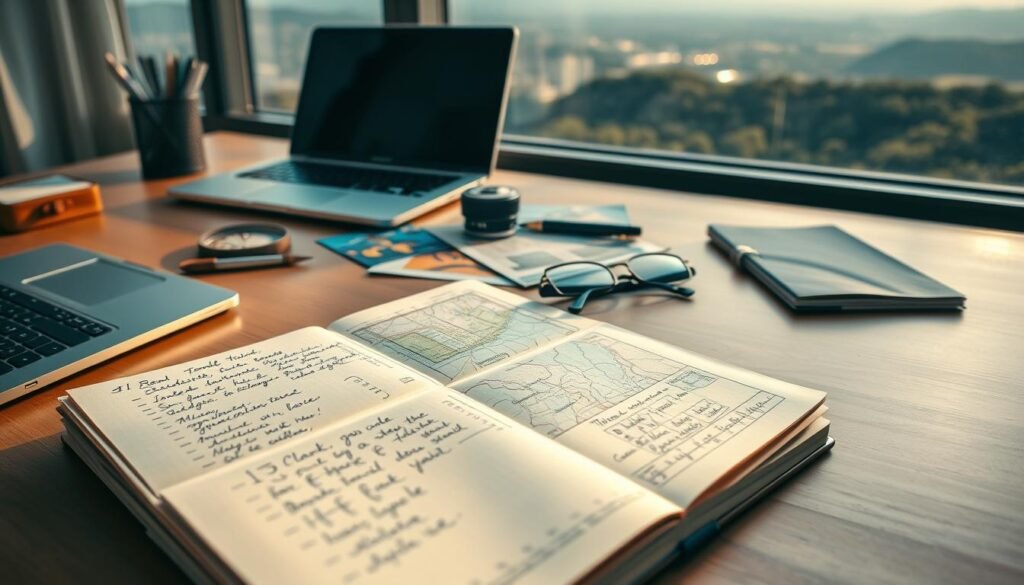
I narrow my choices by how a site feels the moment I step out of the car or train. I look for viewpoints you can reach, trails that welcome both walkers and hikers, and cities where local food finishes the day.
My road-tested criteria: views, trails, food, and vibe
Views matter: I favor overlooks like the Snake River bend or South Rim points you can walk to without fighting crowds.
Trails matter too: options from easy ramps to longer segments such as Bright Angel let groups pick their pace.
Food and vibe close the loop. Cities with street eats, lively restaurants, and friendly people rank higher on my list.
Best time to go and the best way to travel
Timing saves energy: I skip peak desert heat, aim for fall in canyon country, and choose spring for cherry blossoms and Medano Creek flow.
For the way between highlights, I prefer road drives on coastlines and park loops, quick flights for cross-country hops, and rail for dense city corridors.
- I weigh accessibility—iconic views near the road plus longer trails.
- I group nearby stops so you see more without rushing.
- These tips are meant to help people plan smoother travel days.
Iconic American Cities with Big Views, Food, and Culture
![]()
My approach here is simple: give each city a clear daily rhythm so you see museums, parks, and skyline views without rushing.
New York City: museums, parks, and nonstop energy
I split days between The Metropolitan Museum of Art, Central Park, and neighborhoods where every block can feel like a new story.
I often start on the water with the ferry to the Statue of Liberty, then spend a few hours in a museum before refueling at classic restaurants or food halls.
Chicago: skyline views, lakefront miles, and deep-dish delights
Chicago mixes skyline time and water. I walk lakefront miles, snap reflections at Cloud Gate, and take a boat cruise from Navy Pier.
I save the Art Institute for an afternoon and then head up to the Willis Tower Skydeck as the sun goes down.
Washington, DC: free Smithsonian museums and the National Mall
DC is a gift for budget-minded travelers. The National Mall links the Lincoln Memorial, Washington Monument, and U.S. Capitol in a compact loop.
When cherry blossoms bloom at the Tidal Basin, the city can feel like the center of the world; I plan early starts and use transit to skip traffic.
“One anchor museum a day plus an outdoor highlight keeps a city trip balanced and memorable.”
- I book central lodging and walk wherever possible to feel the vibe and meet people.
- Frequent flights and Northeast rail make pairing these cities on one trip easy.
- Tip: pick one museum and one outdoor highlight per day so travel never feels like a blur.
| City | Top Highlights | Quick Tip |
|---|---|---|
| New York City | Statue of Liberty ferry, Central Park, The Met | Start mornings on the water and use food halls for fast meals |
| Chicago | Cloud Gate, Art Institute, Willis Tower Skydeck | Walk lakefront miles, plan sunset at the Skydeck |
| Washington, DC | National Mall, Lincoln Memorial, Smithsonian museums | Visit museums early and see cherry blossoms at the Tidal Basin |
San Francisco: Hills, Bridges, and Bay Views
![]()
San Francisco greets you with steep streets, salt air, and an urge to explore the waterline first. I usually begin with a bay-facing walk or bike across the Golden Gate Bridge so the views recalibrate my sense of scale.
Cable cars are both a fun throwback and a practical way to climb the hills without tiring out. Later I book Alcatraz early and pair the morning tour with an afternoon of city hikes through Golden Gate Park or coastal trails in the Golden Gate National Recreation Area.
The Painted Ladies with the skyline behind them make a classic photo stop. Fisherman’s Wharf and Pier 39 add lively waterfront scenes and sea lions that feel oddly theatrical.best-places-to-visit-in-march
- I rotate between waterfront seafood, neighborhood dim sum, and reservation-worthy restaurants that show the city’s creative food scene.
- When I need calm, I head to coastal trails where the water and cliffs make the city feel wild and tied to the pacific coast.
- Day trips to Muir Woods or nearby wine country stretch the area’s appeal if I have extra time.
“Book Alcatraz early, layer up for breezes, and give yourself extra time—those views will make you stop.”
New Orleans: Music, History, and Seriously Good Food
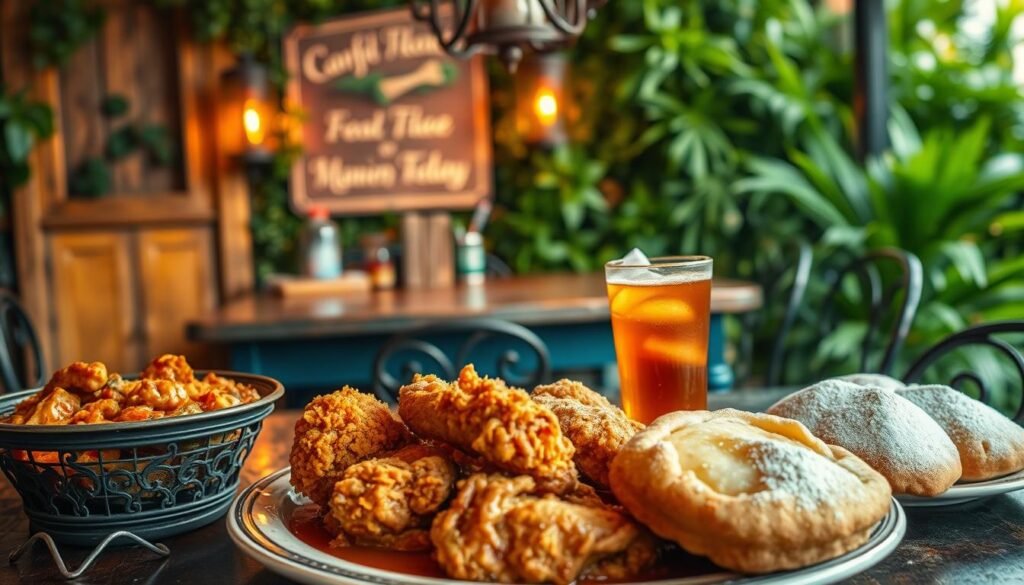
New Orleans unfolds slowly for me: a coffee, a corner band, and layers of history on every block. I walk the French Quarter in the soft morning light, grab beignets, and drift toward Jackson Square to watch morning routines begin.
Live jazz spills from doorways by afternoon and into the night. The way people gather around music is why this city keeps calling me back. Bourbon Street has its buzz, but quieter clubs hold the performances that stay with you.
The Garden District offers a different rhythm. I linger beneath live oaks and admire mansions with iron-laced balconies. St. Louis Cathedral anchors the Quarter and gives the neighborhood a timeless feel.
- I mix hole-in-the-wall po’boys and oysters with a sit-down Creole dinner at classic restaurants.
- One big meal and one casual stop per day leaves room for surprises and snacks.
- This place is built for wandering, small conversations, and late nights that reveal a lot about the local world.
“New Orleans packs culture, soul, and flavor into a walkable canvas—let the streets lead.”
West Coast Road Magic: Pacific Coast Highway and Big Sur

Heading north along the Pacific Coast, I slow down and let the shoreline set the schedule. The stretch from San Francisco up toward Portland folds cliffs, redwoods, and tiny coastal towns into a single, unforgettable route.
The best way to drive the coast and feel like a local
I plan south-to-north so ocean pullouts sit on my right. That small choice makes every overlook effortless and reduces lane changes. For Big Sur I accept fewer daily miles and let dramatic bridges and coves decide the stops.
Don’t-miss views from Mendocino to the sand dunes of Oregon
From Mendocino bluffs to Oregon’s Bandon and its rock formations, the route shifts fast. Redwood groves sit a short detour from the highway. Connectivity can be a bit spotty, so I download maps and keep plans offline.best-places-to-visit-in-costa-rica
- I aim for 100–150 miles per day so the road is the destination.
- Mix city coffee stops with small-town bakeries and flexible trail detours.
- Time photo stops for soft morning or late-afternoon light.
| Segment | Highlights | Suggested miles |
|---|---|---|
| San Francisco → Mendocino | Cliffs, beaches, coastal towns | 80–120 |
| Mendocino → Big Sur | Redwoods, coastal vistas, dramatic bridges | 100–140 |
| Big Sur → Bandon/Coos Bay | Sea stacks, rock formations, sand dunes | 120–150 |
“Set a modest daily target and let the coast set the pace.”
Redwood National and State Parks: Towering Trees, Quiet Trails
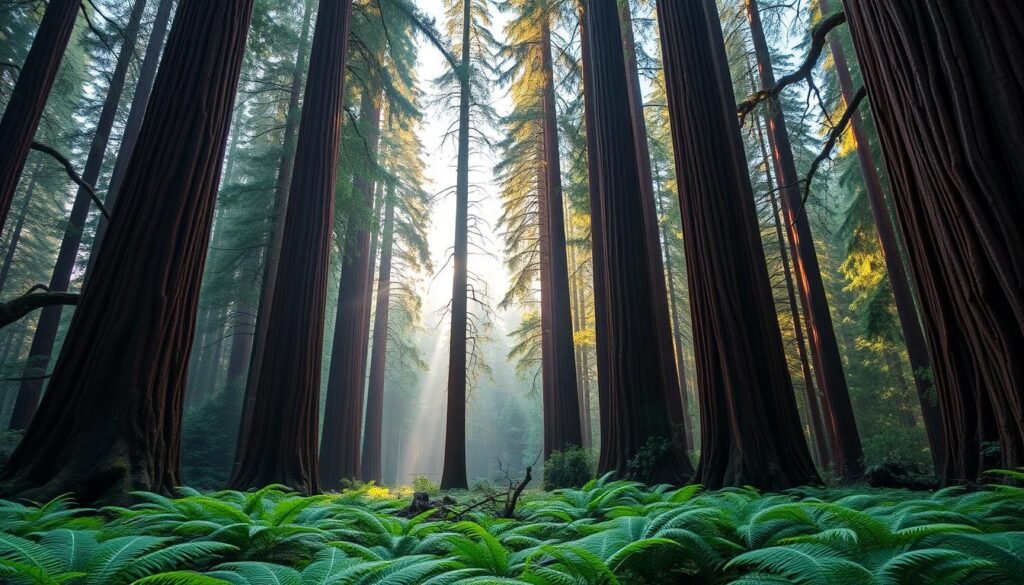
Walking beneath those trunks feels like stepping into a living history book. The redwoods here recalibrate your sense of time the moment you hit a trail.
I pack a picnic, pick a nearby grove, and aim for quiet morning hours when mist makes the forest feel sacred. There are short trails near parking areas for road-trippers and longer loops when I have a full day.
The national park and adjacent state parks blend seamlessly, so I plan routes that link groves, creeks, and a coastal viewpoint. In one day I can wander among giants, then watch waves crash on a nearby beach.
- I carry a simple map and note road conditions after storms.
- Good footwear matters—roots and damp sections are part of the charm.
- I choose a couple of anchor groves rather than trying to do it all.
“Mornings here are calm and misty; the forest feels like a cathedral.”
| Feature | What I do | Why it works |
|---|---|---|
| Trails | Short loops or full-day hikes | Offers flexibility for any schedule |
| Picnic & camping | Pack lunch, find a quiet clearing | Filtered light makes the meal memorable |
| Coastal viewpoints | Combine forest walk with beach drive | Balance between coast and forest in one day |
Grand Canyon, Arizona: Rock Formations, Rims, and Epic Hikes
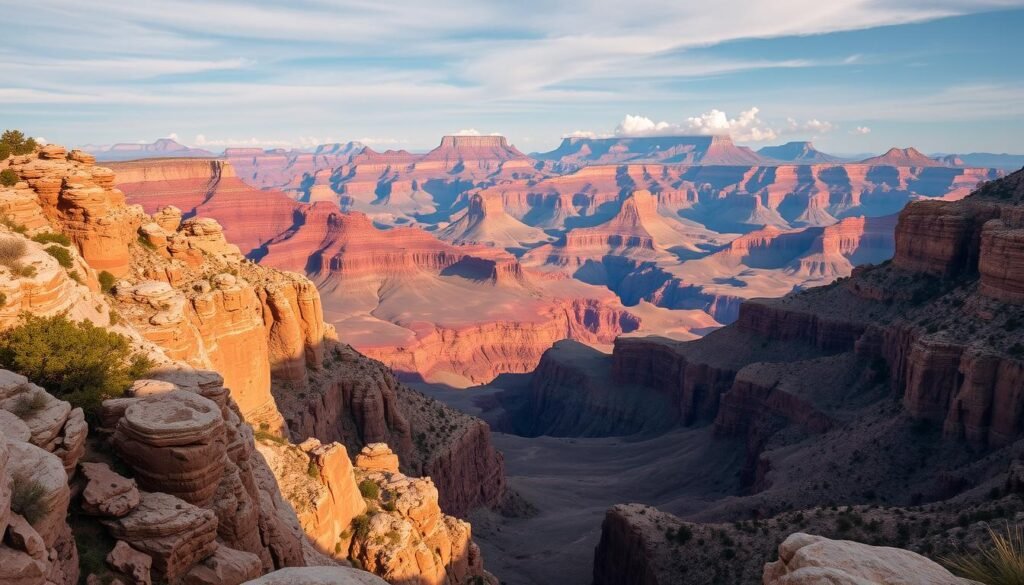
Standing at the rim, I notice how light and shadow rewrite the canyon every hour. That shift makes the layered rock formations feel alive and worth timing for sunrise or sunset.best-places-to-visit-in-january
South Rim viewpoints, Bright Angel Trail, and Desert View Drive
I start along the south rim, looping a few overlooks so I can compare views without backtracking. The park’s overlooks are walkable and give very different perspectives in a short drive.
Bright Angel Trail is my go-to for controlled descents. It drops in stages, has rest houses, and lets me choose how far the hikes will go before I set a firm turn-around time.
When to avoid the heat and how to plan your canyon time
- Aim for spring or fall—shoulder seasons make time on the rim far more pleasant.
- Heat rises fast below the rim; carry extra water, sun protection, and plan firm turn-around points.
- Desert View Drive is my favorite road when I want big panoramas with fewer crowds.
- Book lodging and any permits early; nearby bases work if park options are full.
“Even a short step below the rim changes how the canyon feels—plan for that moment.”
Canyon Country in Utah: Arches, Canyonlands, Capitol Reef, Zion

Utah’s canyon country unrolls like a map of contrasts—fins, arches, and quiet mesas that change by light.
I plan days around early starts and late light. In Arches I watch Delicate Arch glow at sunset and take short, accessible hikes to other spans.
Canyonlands feels like four different worlds: Island in the Sky for overlooks, Needles for meandering trails, Maze for solitude, and Horseshoe Canyon for ancient rock art.
Quick hiking notes and safety
I favor morning hikes and shade-aware routes in this arid area. In Zion the Narrows means wading the river—my tips are to check flow, rent proper footwear, and begin early.
Capitol Reef gives quieter park time and nearby slot canyons that need technical skill. These parks are close enough to loop, so I group stops to reduce drives and fit more trails.best-places-to-visit-in-february
“Time your overlooks for dawn and dusk—the rock formations reward a little planning.”
Yellowstone and Grand Teton: Wildlife, Peaks, and Alpine Lakes

A day that begins with steam and ends beside a reflective mountain lake is why I keep coming back to these parks.
Yellowstone spans a huge area of geothermal wonder. I plan my time around Old Faithful’s eruption windows and the Grand Prismatic boardwalks so I see the main highlights without rushing.
Lamar Valley feels like a safari at dawn. I go early or late for the best wildlife sightings and let a slow stretch of road become my lookout for bison, elk, and wolves.
Old Faithful, Grand Prismatic, and the Snake River overlook
Yellowstone Lake is my reset button — big water, open sky, and a quiet place between steam basins. I pick one lakeside trail for an easy day and one alpine route when I want altitude and sweeping views.
The jump into Grand Teton brings instant mountain drama. The Snake River overlook gives that classic sunrise reflection, and its short viewpoints reward early alarms.
“I time mornings for eruptions and evenings for reflected peaks; the two parks pair perfectly for contrast and calm.”
| Spot | Highlight | My tip |
|---|---|---|
| Old Faithful | Regular eruptions, visitor center | Check eruption times, arrive early for viewing decks |
| Grand Prismatic Spring | Vivid colors, boardwalk loop | Use the overlook for wide views, walk the boardwalk for detail |
| Lamar Valley | Wildlife viewing | Scout pullouts at dawn or dusk, bring binoculars |
| Snake River Overlook | Iconic mountain reflections | Plan sunrise and layer clothing for mountain weather |
Travel here rewards early starts, simple planning, and a willingness to slow down. Roads are long; I batch nearby sights so I see a lot without wasting energy. These places feel like home for sunrise memories — worth every early alarm.
For a practical route and timing tips, see my detailed road trip notes at Yellowstone–Grand Teton road trip guide.
Great Smoky Mountains: Waterfalls, Fall Color, and Ridge Views
Morning light often turns the Smokies into a soft blue haze that rewrites every ridge and trail. I use that hush to choose where I’ll hike, drive, and pause for photos.
Clingmans Dome, Cades Cove, and leaf-peeping tips
Clingmans Dome gives quick ridge-top views that help me plan the rest of the day. From that high spot the valley lines and forest seams read like a map.
- I run the Cades Cove loop early for wildlife and quiet cabin glimpses.
- Laurel Falls is my go-to for a short paved trail and a reliable waterfall stop.
- On Roaring Fork I pair scenic drives with short hikes when the trees light up in fall.
- Summer brings lush greens and warm air; fall color feels like a different trip through the same mountain range.
- Leaf-peeping tips: go early, pack layers, and use pullouts for unplanned photos.
Short paved walks and longer mountain hikes make it easy to tailor a day to any group. I bring a simple picnic, set a slow pace, and let the Smokies feel like home.
“One more bend in the road often reveals a new view.”
Great Sand Dunes National Park: Surf the Slopes, Chase the Creek
I head to the dunes at first light when the sand cools and the ridgelines sharpen into long shadows.
Star Dune is the marquee climb here — the highest dune in North America. I sandboard down, hike short boot-filled trails, and time my steps for soft morning light. Medano Creek runs in spring and early summer, turning the base into a beach-like ribbon of water and sand.
Sandboarding Star Dune and seasonal Medano Creek
Practical tips: I bring goggles, a face covering, spare socks, and a soft brush to clear sand from gear. Even brief hikes feel epic on powdery slopes, so I set realistic goals and celebrate small summits.
- I hit the dunes early for cooler sand and unforgettable views.
- Sandboarding or sliding is a kid-at-heart joy — protect eyes and electronics.
- Afternoon winds can pick up; check forecasts, wear layers, and carry plenty of water.
- Zapata Falls is a short detour and a perfect cool-down hike.
| Feature | What I do | Why it works |
|---|---|---|
| Star Dune | Climb at dawn, sandboard descent | Cool sand and long shadows enhance photos and comfort |
| Medano Creek | Play, build sand castles, cool off | Seasonal water creates a rare beach feel at the dune base |
| Zapata Falls | Short hike, cold splash | Quick, refreshing detour after dune time |
“This park flips expectations: mountains one side, sand waves the other — a mix that makes everyone climb back up for another run.”
Island and Coastal Escapes: Hawaii, Florida Keys, and Outer Banks
I plan these coastal escapes around sunrise views, reef swims, and easy scenic drives. Each option gives a different kind of water time and a clear rhythm for a week of relaxed travel.
Maui means an all-day Road to Hana drive for me—waterfalls, black-sand coves, and cliffside pullouts that force a slow pace. I treat Haleakalā sunrise as a ritual: reserve ahead, bundle up, and bring hot coffee for the thin air at the park summit.best-time-to-visit-portugal
Oahu mixes Waikiki energy with the quiet weight of Pearl Harbor. I split beach hours and reflective museum time so a day can be both lively and grounded.
Maui’s Road to Hana and Haleakalā sunrise
I stop often on the Hana route for short walks and views. For Haleakalā, I plan timing and layers for the high-altitude chill.
Waikiki energy and Pearl Harbor history
Waikiki’s beach scene is classic; Pearl Harbor’s USS Arizona Memorial gives a sobering, important reminder of history while nearby sands let me reset.
Key West sunsets, coral reefs, and scenic miles of bridge drive
In the Keys I hop state parks for reefs and beaches. John Pennekamp’s coral reef is perfect for snorkeling, and the Old Seven Mile Bridge makes a memorable drive above clear water.
Outer Banks lighthouses, dunes, and the Wright Brothers
The Outer Banks deliver wind, climbs, and history: Cape Hatteras, Jockey’s Ridge State Park dunes, and the Wright Brothers National Memorial. I plan lighthouse climbs at golden hour.
“Link an island, reef, or lighthouse run for a week that balances water time, easy drives, and small doses of history.”
For more tropical ideas and seasonal timing, see this guide to tropical escapes: tropical vacations in the US.
City Breaks I Keep Returning To: San Diego, Boston, Portland, Austin
A good city break balances one big signature stop with small finds that keep the day feeling full but relaxed. I pick a single anchor and then let neighborhoods fill the rest of the hours.
Beaches and Balboa Park in San Diego
San Diego is my feel-good city: beach mornings, museum time at Balboa Park, and the San Diego Zoo if I want a compact animal day.
At dusk I walk La Jolla Cove for sea lions and easy snorkeling. For more ideas, see things to do in San Diego.
Freedom Trail and North End eats in Boston
I follow the Freedom Trail for a tight slice of history, then dive into North End restaurants for pasta and cannoli. One concentrated walk gives a full day of landmarks and flavor.
Cafés, trails, and brewpubs in Portland and Austin
Portland is a café-and-trails rhythm: bike paths, river walks, and brewpubs that stretch an afternoon into an evening.
Austin mixes live music, tacos, food trucks, and lakeside hangs. I love how the city makes room for work and play, and how people shape the vibe.
“Pick one signature stop, then wander; short city breaks often reveal the best surprises.”
These four cities reset my pace between park-heavy trips. Good food anchors each day and keeps travel feeling simple and lively.
best place to visit in usa: My Shortlist for First-Timers
I keep this shortlist compact so first-timers get iconic views, simple logistics, and varied scenery without wasted time. These four picks balance transit options and easy loops for quick wins.
Grand Canyon — South Rim
grand canyon’s South Rim gives instant panoramas. A short walk along overlooks and a taste of Bright Angel Trail deliver that “wow” without long hikes.
San Francisco highlights
san francisco pairs the Golden Gate Bridge, cable cars, and Alcatraz with neighborhoods built for good meals between sights. It’s an efficient mix of views and food.best-time-to-visit-ireland
New York City rhythm
One museum, one park, one neighborhood per day is my rhythm in NYC. The Met and Central Park give variety and easy transit links.
Great Smoky Mountains
The Smokies add waterfalls and ridge views. Clingmans Dome and Cades Cove are quick wins inside the national park for fall color and calm trails.
- This list is my recommended best way to get iconic moments fast.
- Stack mornings for views and afternoons for museums; book must-see entries early.
“Keep one night free for a new restaurant—some of the best memories happen after dinner.”
Conclusion
, Use this guide as a travel palette: pick a city anchor, add a park day, and save room for surprises. I suggest starting with one coast or a single cluster so your time stretches farther and feels calm.
I built the list so you can choose places visit by mood: san francisco hills for water and neighborhoods, the Grand Canyon south rim for raw views, or sand dunes for early light and play. The united states shines in contrasts — cities and quiet trails, trees and mountains.
If you want to visit more places, stack a city night with a park day, carry water, chase early light, and leave space for detours. My hope is simple: this short list helps you plan travel that makes great memories at home and beyond.


